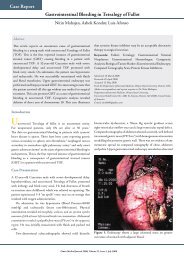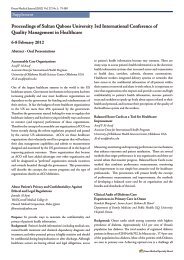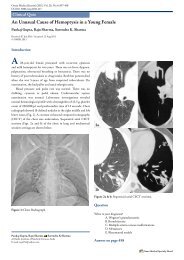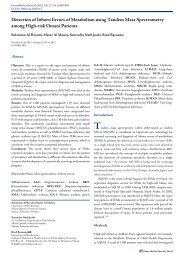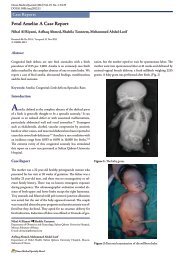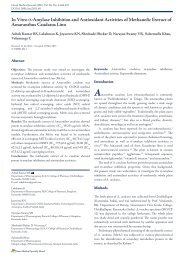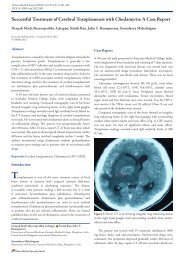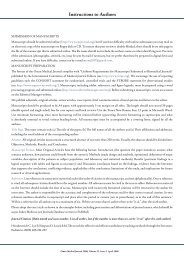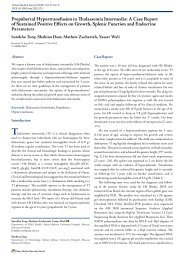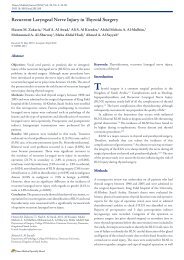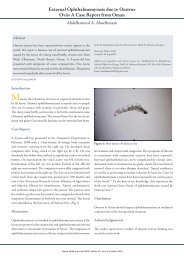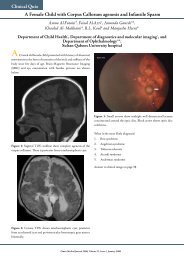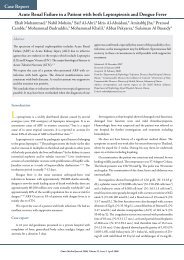Incidence of Diabetic Ketoacidosis during Ramadan Fasting ... - OMJ
Incidence of Diabetic Ketoacidosis during Ramadan Fasting ... - OMJ
Incidence of Diabetic Ketoacidosis during Ramadan Fasting ... - OMJ
You also want an ePaper? Increase the reach of your titles
YUMPU automatically turns print PDFs into web optimized ePapers that Google loves.
<strong>Incidence</strong> <strong>of</strong> <strong>Diabetic</strong> <strong>Ketoacidosis</strong> <strong>during</strong> <strong>Ramadan</strong> <strong>Fasting</strong> in Benghazi-Libya<br />
Rafik Elmehdawi 1 , Mohammed Ehmida 2 , Hanan Elmagrehi 3<br />
Abstract<br />
Objectives: <strong>Ramadan</strong> is the ninth month on the lunar calendar<br />
and it is a holy month for Muslims <strong>during</strong> which all healthy adults<br />
must fast from dawn to sunset. The risk <strong>of</strong> diabetic ketoacidosis<br />
is thought to be higher <strong>during</strong> <strong>Ramadan</strong> fasting due to insulin<br />
and glucagon alterations.<br />
Methods: A descriptive retrospective analysis <strong>of</strong> the records <strong>of</strong><br />
all patients admitted with diabetic ketoacidosis to all Benghazi<br />
hospitals <strong>during</strong> the lunar year 1428 Hijri (2007-2008).<br />
Results: Fifteen episodes occurred <strong>during</strong> <strong>Ramadan</strong> compared to<br />
a mean <strong>of</strong> 19.45 episodes/month <strong>during</strong> the other lunar months<br />
(p
<strong>Incidence</strong> <strong>of</strong> <strong>Diabetic</strong> <strong>Ketoacidosis</strong>... Elmehdawi et al.<br />
<strong>of</strong> ketonuria (2+ or more). 5,6 The severity <strong>of</strong> DKA was defined<br />
according to the American diabetes association (ADA) criteria as;<br />
mild: pH 7.25-7.30, moderate: pH 7.24-7, and severe: pH
<strong>Incidence</strong> <strong>of</strong> <strong>Diabetic</strong> <strong>Ketoacidosis</strong>... Elmehdawi et al.<br />
Table 2: Frequency <strong>of</strong> different precipitating factors<br />
Precioitating factors <strong>Ramadan</strong> Other months p-value All months<br />
Infection 7 (46.6%) 37 (18.3%) 0.008 20.2%<br />
Miss dosing 5 (33.3%) 80 (39.6%) 0.5 39.2%<br />
No obvious cause 2 (13.3%) 30 (14.8%) 0.9 14.7%<br />
1 st presentation 1 (6.6%) 42 (20.8%) 0.2 19.8%<br />
Others 0% 13(6.4%) 0.3 6%<br />
Total 15 202 217 100%<br />
Discussion<br />
DKA episodes in adults <strong>during</strong> the lunar year 1428 Hijri accounted<br />
for about 80% <strong>of</strong> all DKA episodes in Benghazi. Contrary to the<br />
general belief that DKA is expected to increase <strong>during</strong> <strong>Ramadan</strong>,<br />
particularly in those with type-1 DM, this study showed that there<br />
is no increase in the incidence <strong>of</strong> DKA <strong>during</strong> <strong>Ramadan</strong> (figure 1),<br />
as a matter <strong>of</strong> fact the incidence <strong>during</strong> <strong>Ramadan</strong> was significantly<br />
lower than the incidence <strong>during</strong> the other lunar months. 1,2 The<br />
reason behind this is not clear, however one explanation might<br />
be because the diabetics prefer not to lose a day <strong>of</strong> fasting so they<br />
try to improve their glycemic control <strong>during</strong> <strong>Ramadan</strong> and this<br />
was reflected by the frequency <strong>of</strong> DKA recorded. Moreover, the<br />
mortality rate and the length <strong>of</strong> hospitalization <strong>during</strong> <strong>Ramadan</strong><br />
did not differ from those <strong>during</strong> other lunar months despite that,<br />
the two groups <strong>of</strong> patients were <strong>of</strong> equivalent mean <strong>of</strong> age, and<br />
both groups presented a similar rate <strong>of</strong> co-morbidity and an equal<br />
chance <strong>of</strong> being managed at an intensive care unit (table 1).<br />
M= Moharam, S= Safar, R1= Rabie-1, R2= Rabie-2, J1=<br />
Jumada-1, J2= Jumada-2, Raj=Rajab, SB= Shaban, R= <strong>Ramadan</strong>,<br />
Number <strong>of</strong> cases<br />
30<br />
25<br />
20<br />
15<br />
10<br />
5<br />
0<br />
M S R1 R2 J1 J2 Raj. SB. R SW DQ. DH<br />
SW= Shawal, DQ= Dhulqada, DH= Dhulhajja<br />
Figure 1: Distribution <strong>of</strong> the episodes according to the lunar months<br />
One might argue that there was no increase in DKA incidence<br />
<strong>during</strong> <strong>Ramadan</strong> simply because most diabetics do not fast <strong>during</strong><br />
<strong>Ramadan</strong>, but this was not the case as Libyan diabetics fast for<br />
a mean <strong>of</strong> 28.5±4.6 out <strong>of</strong> the 30 days. 7 Similarly, Abusrewil et<br />
al reported from Libya that 87% <strong>of</strong> type-1 patients finished 30<br />
days <strong>of</strong> fasting <strong>during</strong> <strong>Ramadan</strong>. 4 Surprisingly the most common<br />
precipitating factor for DKA <strong>during</strong> <strong>Ramadan</strong> was concurrent<br />
infection not dose reduction as one might expect, however dose<br />
reduction could still be an important c<strong>of</strong>actor even in those with<br />
infection as it would not be unusual for diabetics to reduce their<br />
doses <strong>during</strong> <strong>Ramadan</strong> in order to avoid hypoglycemia <strong>during</strong> day<br />
time. 1,7 The dose reduction alone may not be enough to precipitate<br />
DKA <strong>during</strong> ordinary conditions but when such patients have an<br />
acute infection, their usual doses become insufficient to meet the<br />
stress demands induced by raised catecholamines and steroids,<br />
therefore if these patients fail to adjust their insulin requirements<br />
they slide into DKA. Despite not being statistically significant<br />
DKA episodes <strong>during</strong> <strong>Ramadan</strong> were more frequently severe and<br />
patients had a higher serum sodium and urea indicating a tendency<br />
towards a more severe degree <strong>of</strong> dehydration. Nevertheless theses<br />
differences did not generally affect the outcome adversely.<br />
Conclusion<br />
Contrary to the general belief that DKA is expected to increase<br />
<strong>during</strong> <strong>Ramadan</strong>, this study showed that there was no increase in<br />
the incidence <strong>of</strong> DKA <strong>during</strong> <strong>Ramadan</strong>. Furthermore, the current<br />
study demonstrated that neither the mortality nor the length<br />
<strong>of</strong> hospital stay was increased <strong>during</strong> <strong>Ramadan</strong>. These findings<br />
suggest that diabetics can safely fast <strong>during</strong> <strong>Ramadan</strong> without<br />
an increased risk <strong>of</strong> diabetic ketoacidosis provided that they are<br />
well educated and their insulin doses and blood glucose levels are<br />
properly adjusted and monitored <strong>during</strong> fasting.<br />
Study limitations<br />
The small number <strong>of</strong> episodes <strong>during</strong> <strong>Ramadan</strong> made it difficult<br />
to compare the minor differences between means to assess the<br />
significance. Hence, studies with larger number <strong>of</strong> patients are<br />
recommended.<br />
Oman Medical Journal 2009, Volume 24, Issue 2, April 2009
<strong>Incidence</strong> <strong>of</strong> <strong>Diabetic</strong> <strong>Ketoacidosis</strong>... Elmehdawi et al.<br />
Acknowledgments<br />
The authors reported no conflict <strong>of</strong> interest and no funding has<br />
been received on this work.<br />
References<br />
1. Salti I, Benard E, Detournay B, Bianchi-Biscay M, Le Brigand C, Voinet C,<br />
et al. EPIDIAR study group, A population based study <strong>of</strong> diabetes and its<br />
characteristics <strong>during</strong> the fasting month <strong>of</strong> <strong>Ramadan</strong> in 13 countries: results<br />
<strong>of</strong> the epidemiology <strong>of</strong> diabetes and <strong>Ramadan</strong> 1422/2001 (EPIDIAR) study.<br />
Diabetes Care 2004; 27: 2306-2311.<br />
2. Al-Arouj M, Bouguerra R, Buse J, Hafez S, Hassanein M, Ibrahim MA,<br />
et al . Recommendations for Management <strong>of</strong> Diabetes During <strong>Ramadan</strong>.<br />
Diabetes Care. 2005; 28:2305-2311.<br />
3. Kadiki OA, Moawad SE, Khan ZA, Reddy MRS, Marzoug AA. Diabetes<br />
Mellitus and <strong>Ramadan</strong>. Garyounis Med J 1989; 12:32-34.<br />
4. Abusrewil SS, Turki HM, Osman F, Kabuka M, Mgadmi A. <strong>Ramadan</strong><br />
<strong>Fasting</strong> and <strong>Diabetic</strong> Control in Adolescents and young Adult. Jamahiriya<br />
Med J. 2003; 2:49-50.<br />
5. Kitabchi AE, Umpierrez GE, Murphy MB, Kreisberg RA. Hyperglycemic<br />
crises in adult patients with diabetes: a consensus statement from the<br />
American Diabetes Association. Diabetes Care. 2006; 29:2739-2748.<br />
6. Kitabchi AE, Umpierrez GE, Murphy MB, Barrett EJ, Kreisberg RA, Malone<br />
JI, et al. Hyperglycemic crises in diabetes. Diabetes Care 2004; 27:94-102.<br />
7. Elmehdawi RR, Mukhtad NA, Allaghi NI, Elmajberi SJ. <strong>Fasting</strong> <strong>of</strong> <strong>Ramadan</strong><br />
in people with diabetes in Benghazi-Libya. Presented at the 7th Libyan<br />
diabetes and endocrinology conference. 2009, Tripoli-Libya. Abstract; p. 9.<br />
“CME Credits for Reviewers”<br />
The Oman Medical Specialty Board would like to announce the awarding <strong>of</strong><br />
Category 2 CME credits to peer reviewers <strong>of</strong> the Oman Medical Journal. The<br />
Oman Medical Specialty Board will award 1 CME credit for each manuscript<br />
reviewed.<br />
Oman Medical Journal 2009, Volume 24, Issue 2, April 2009



